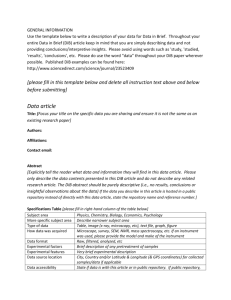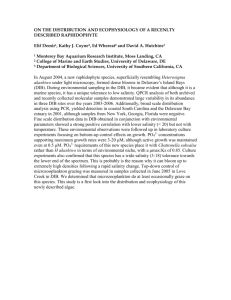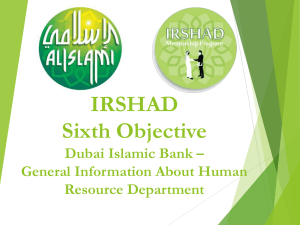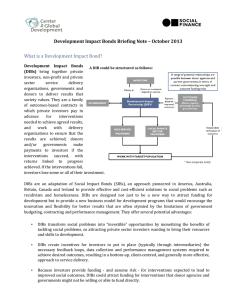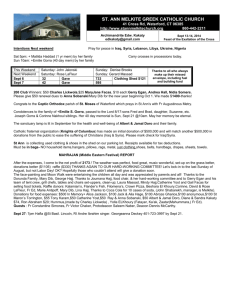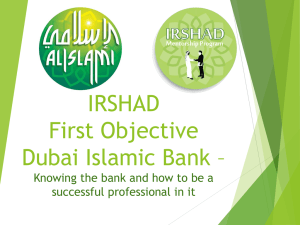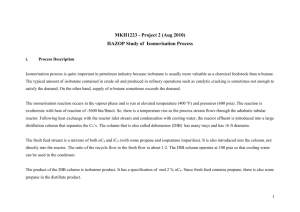DEVELOPMENT IMPACT BONDS WORKING GROUP MEETING 05 OCTOBER 2012 BACKGROUND
advertisement
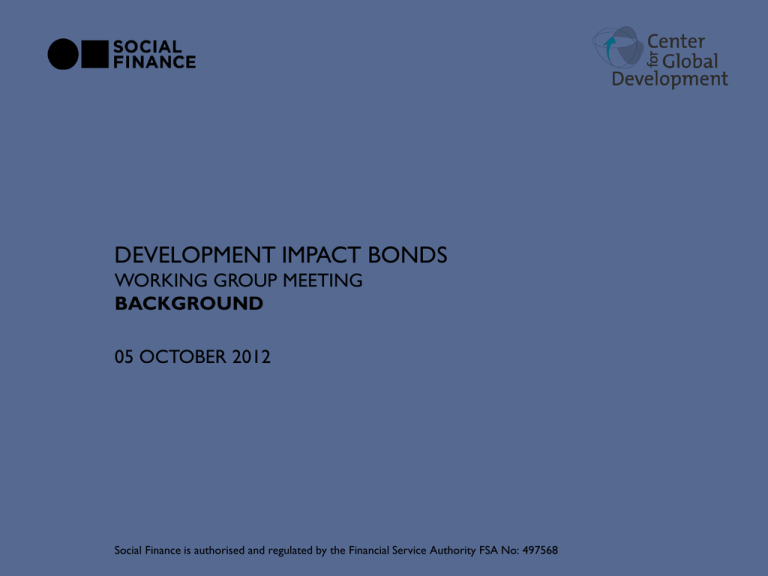
DEVELOPMENT IMPACT BONDS WORKING GROUP MEETING BACKGROUND 05 OCTOBER 2012 Social Finance is authorised and regulated by the Financial Service Authority FSA No: 497568 OBJECTIVES During the October 5 meeting we will: • Explore six DIB case study opportunities • Identify and explore cross-cutting issues, using case study examples to refine thinking around principles for assessing when a DIB is appropriate and designing DIB pilots • Identify interest in each case study opportunity • Define work required to take case studies forward • Agree focus for the third Working Group meeting ©Social Finance & Center for Global Development 2012 2 DIB CASE STUDIES Following CGD and Social Finance’s initial screening of a long list of DIB opportunities, and a conference call with working group members on September 4th, it was agreed that the working group will assess in further detail the following opportunities: • Elimination of sleeping sickness in Uganda (Social Finance) • HIV treatment as prevention in Swaziland (Clinton Health Access Initiative) • Improving the quality of low cost private schools (Lion’s Head Global Partners) • Access to quality secondary education in Uganda (Social Finance) • Improving business development services (U.S. Agency for International Development) • Energy efficient buildings (Overseas Private Investment Corporation) The first five ideas were discussed briefly during the September 4 th call; a proposal from OPIC for energy efficient buildings has been added since then, as a response to interest in the areas of clean energy and private sector development. ©Social Finance & Center for Global Development 2012 4 CASE STUDIES A one-page overview of each of the six opportunities that will be presented on October 5th is provided here. Please note that we are re-circulating these slides from the slide deck for the September 4th call as a reminder of the DIB ideas to be discussed; some of the thinking and questions around these ideas have progressed since that call. ©Social Finance & Center for Global Development 2012 HEALTH: SLEEPING SICKNESS Elimination of East African sleeping sickness in Uganda Social issue • East African sleeping sickness threatens 9 million people in Uganda. • It is expensive and difficult to diagnose and treat in humans - as a result it is often fatal. Social opportunity • Recent scientific research has demonstrated that preventative measures to reduce instances of human sleeping sickness exist; cattle have been found to act as the main reservoir for the human infective parasite and cost effective interventions to treat them have been piloted. • There is potential for a DIB to rapidly scale this intervention model and make the gains sustainable in the longer term, potentially eliminating instances of East African sleeping sickness in Uganda. DIB motivation • Sustained funding: challenge is rapid scaling of cattle treatment interventions to contain the spread of the disease and ensure that systems can be established for sustaining short-term gains from mass treatment over the longer-term. DIB value added • Stakeholder coordination: implementation of the necessary mass treatment is logistically complex and requires the involvement of a number of stakeholders; there is uncertainty around ability of current infrastructure to deliver intervention at scale required. • Targeted interventions: investor involvement creates a strong incentive for effective delivery and performance management. • Access to finance: front-loading expenditure is key to minimising the spread of disease and preventing potential cross-over with West African sleeping sickness. Status • Social Finance is currently working with H20 Ventures, DfID and others to undertake detailed feasibility work to develop a sleeping sickness DIB. • We are aiming to develop the fundamentals of a business case for donor outcomes funding by the autumn with a view to progressing to implementation next year. ©Social Finance & Center for Global Development 2012 5 HEALTH: HIV TREATMENT AS PREVENTION HIV treatment as prevention in Swaziland Social issue • Swaziland has the world´s highest HIV prevalence rate (>25%) and faces escalating and unsustainable treatment and social costs if the rate of new infections is not brought under control. • At present only 80,000 of an estimated 200,000 infected individuals in Swaziland are receiving regular treatment. Social opportunity • New evidence suggests that it may be possible to prevent up to 95% of new infections if people are moved onto treatment early enough. If rolled out quickly, this could stabilise ongoing HIV treatment costs at a sustainable level. DIB motivation • Better targeting of resources: there is considerable pressure to increase the efficiency and effectiveness of limited resources to prevent new infections. We understand that robust models exist to infer new infections avoided from the [number / %] of infected individuals on treatment. • Sustained funding focus: funding is required to not only move individuals onto treatment, but also to retain them on treatment to reduce new infections. DIB value added • Targeted intervention structure: DIB could create incentives to create locally appropriate, quality services that ensure infected individuals are placed on treatment quickly and continue treatment correctly. • Access to finance: front-loading of finance is needed to enable rapid roll-out of treatment to infected individuals who are not currently receiving treatment. Status • The Clinton Health Access Initiative is currently working with other stakeholders in Swaziland to develop a robust operational model to enable implementation of this approach. • We are awaiting further detail around the timing of implementation, potential outcome metrics and the scale of required funding. • Further work would be needed to assess whether a DIB would be an appropriate financing mechanism for this intervention. ©Social Finance & Center for Global Development 2012 6 EDUCATION: LOW FEE PRIVATE SCHOOLS Improving access to quality low fee private schools Social issue • A significant percentage of education in South Asia and beyond is provided through informal, often family-run, low cost private schools that have evolved to serve local need and are highly accountable to parents and communities. • While widely accessible, these schools often generate healthy revenues, but struggle to access commercial finance to improve and increase school facilities and to train their staff. Social opportunity • Low income families often value the accountability and convenience of private schools. Low cost private schools need access to capital to expand, but this could be packaged with quality incentives to ensure school standards are improving. DIB motivation • Quality of service incentive: low fee private schools need access to loan finance to grow. Including a quality incentive with such finance could improve the accountability of such schools and help to ensure that they are providing a high quality education. DIB value added • Access to finance: a DIB could be used to raise investment for private school investment funds. Investor returns could be fully or partially tied to quality outcomes for the schools receiving investment. Outstanding questions • Is outcomes-based investment needed or would donor commitment to pay for outcomes be sufficient to enable loan funds to offer quality incentives / reduced interest rates to low cost private schools? ©Social Finance & Center for Global Development 2012 7 EDUCATION: QUALITY SECONDARY EDUCATION Access to quality secondary education in Uganda Social issue • Number of secondary school places in Uganda is insufficient to meet demand and in many cases education quality is poor. Many donors are reluctant to fund the construction of school infrastructure without a link to education quality. Social opportunity • Investing in increasing the availability and quality of secondary education in Uganda gives children access to the knowledge and skills which translate to employment and economic empowerment for themselves and their children. Interventions might include capital investment to establish new low fee private schools, teacher training, school leadership development and performance-based incentives at the school, teacher and household level. DIB motivation • Quality of service incentives: creation of secondary school places alone is necessary, but not sufficient for improving education outcomes. A DIB could create a strong incentive to optimise education quality. DIB value added • Access to finance: creation of school places requires significant upfront investment in education infrastructure and training – a DIB could enable governments and donors to spread this cost over time and link payment to education quality. • Targeted interventions: structure can create incentives to address hard-to-reach populations such as girls and young people in rural areas. Outcomes-focus should enable locally-appropriate interventions to deliver strong education outcomes. Outstanding questions • Are investors and donors willing to commit to the longer timelines required to measure outcomes? • Would a percentage of success payments need to be triggered by enrolment / attendance and / or pupil retention? • Should a programme of this kind be structured around a network of only new schools, or the availability and quality of secondary education overall in a particular location? • Are national exams the right quality of education indicator? Should payments be based on absolute or relative performance? ©Social Finance & Center for Global Development 2012 8 MARKET DEVELOPMENT: BUSINESS DEVELOPMENT SUPPORT Outcomes-based funding for business development support Social issue • Donor agencies currently spend hundreds of millions of dollars a year funding business development services (BDS) with no certainty of their impact in terms of supporting local organisations to access finance and grow their businesses. • At the same time, impact oriented investors struggle to source high quality deals and find it uneconomical to support and manage low value investments. Social opportunity • An investor-backed fund to pay for business development services, with outcome payments triggered if BDS providers support local businesses to raise and repay third party finance could increase the availability of investible opportunities, create a recycling mechanism for VC technical assistance funds and, potentially, reduce the transaction costs of small deals to investors. DIB motivation • Quality of service incentives: existing donor funding for business development services is not allocated on an outcomes basis and its impact is poorly understood. • Better targeting of resources: outcome-based payments could increase the incentive for BDSs to target their support to businesses that would be attractive to investors; controls may be needed to ensure a focus on market gaps. DIB value added • Access to finance: existing BDS providers are capital constrained and an often overlooked component of the market infrastructure. Without an initial investment and working capital they are unable to participate in outcomes-based contracts. • Targeted interventions: investors will have a strong interest in selecting high quality BDS providers to source and prepare high potential local businesses for investment. Outstanding questions • Would there be a conflict of interest in investment funds investing in a DIB to support business development services? • How could BDS support be targeted towards priority enterprises in terms of sector and stage of development? • What scale of capital would be needed? Where could this be piloted? ©Social Finance & Center for Global Development 2012 9 ENERGY: ENERGY EFFICIENCY Outcome-based funding for energy efficiency implementation in Africa Social issue • Fossil fuel power generation is highly-polluting leading to population healthcare issues. • Traditional diesel-based power sources are expensive for consumers, as well as their governments who often subsidize these costs. Social opportunity • Studies have proven that environmental improvement is directly correlated to social and economic advancement. • Creating energy efficiency will reduce energy costs enabling governments to direct their budgets to other social purposes. • Savings from energy efficiency can be used for construction of more responsible renewable energy development and/or extending systems to serve more remote, off-grid areas. • Retrofit activities will result in job creation causing ripple effect economic growth. • There is potential to leverage OPIC and other financing institutions, as well as the private sector to participate in this model given the definable financial result of the model. DIB motivation • Sustained funding: the availability of funding will result in immediate energy savings and reduction of greenhouse gases that will be measurable. While the savings will be immediate, they will also be sustained over the long term. • Better targeting of resources: reduction of energy demand is more effective financially and environmentally than adding new energy sources. The model is easily replicable across markets. DIB value added • Stakeholder coordination: potential for DIB to identify reliable equipment and service providers to spur interest in the market opportunity and effectively implement planned improvements. • Targeted interventions: investor involvement creates a strong incentive for effective delivery and performance management in order to realize tangible returns (and therefore, reinvestment opportunity). • Access to finance: front-loading expenditures will have near-immediate results on energy savings, budget relief, job creation, and environmental improvement. ©Social Finance & Center for Global Development 2012 11 DIB GUIDELINES AND PRINCIPLES Following the case study presentations, we will discuss cross-cutting issues and general principles for assessing DIB opportunities and implementing pilots. Note that the following slides were also presented on the September 4th update call, and are examples of issues we may wish to revisit at the working group meeting. ©Social Finance & Center for Global Development 2012 DIB DEVELOPMENT CHALLENGES The DIB opportunities that we screened were in need of an approach that addresses one or more of the following development challenges. Is this an appropriate articulation of the challenges which a DIB structure is well suited to solve? 1. Poor targeting of resources – existing funds are inefficiently allocated to areas and / or populations of most need 2. No quality of service incentive – quality of service is not rewarded, but access to services alone is insufficient to deliver outcomes 3. Short-term funding focus – a longer-term incentive is needed to maintain or scale-up results 4. Insufficient public funds – current activities constrained by inefficient spending or public sector revenue limitations 5. Inefficiencies created by need for donor accountability – conventional upfront project funding inflexible in terms of timing and focus of spending IN SOME CASES IT MAY BE POSSIBLE TO ADDRESS THESE CHALLENGES THROUGH OUTCOMES-BASED APPROACHES THAT DO NOT INVOLVE INVESTORS – E.G. RESULTS BASED FINANCE OR RESULTS BASED AID ©Social Finance & Center for Global Development 2012 12 DIB ADDED VALUE We identified three ways that DIBs could increase the efficiency and effectiveness of development programmes. Following the case study discussions we will evaluate whether these are appropriate factors for assessing DIB opportunities. 1. Access to finance • Investor involvement enables funding to be front-loaded where required • Upfront funding for service providers enables them to more easily participate in results-based contracts • May increase outcome-funder appetite for programmes that would otherwise be dismissed due to uncertainty around intervention effectiveness or ability to scale-up 2. Stakeholder coordination • DIBs create a mechanism for coordinating government, donor agencies, private sector investors and nongovernment service providers • Focus on outcomes means that incentives are aligned for outcome funders, investors and service providers 3. Targeted interventions • Investor involvement creates a stakeholder group with a strong incentive to ensure effective and efficient delivery of outcomes • Outcomes focus enables flexibility in the intervention approach and allows for locally tailored and innovative approaches to service delivery where applicable • Structure can create incentives to focus on preventative measures, last mile problems and hard-to-reach populations ©Social Finance & Center for Global Development 2012 13 DIB SCREENING METHODOLOGY We assessed potential DIB opportunities against a set of questions informed by Social Finance’s experience of assessing the feasibility of Social Impact Bonds in the UK and other developed economies. 1. DIB feasibility • Is there a well-established intervention model? • Is there good potential for defining & measuring outcomes as payment triggers? • Is there good potential for impact attribution? • Is there a clearly defined target population? • Would an outcomes-based approach add value? • Could a DIB structure offer additional value? 2. Stakeholder engagement • Do we know of a donor agency for which this is a priority? • Do we know of a government for which this is a priority? • Do we have potential champions for this idea? • Is this likely to be an area of interest for investors? 3. Stage of development • Is there a clear country focus and / or strong development partners? • Are relevant stakeholder conversations already underway? • Can we identify strong development partners? ©Social Finance & Center for Global Development 2012 14
